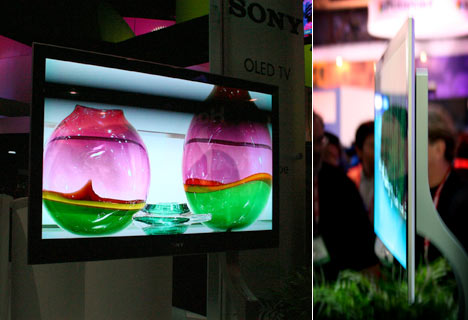
Despite Kaz Hirai having taken over the reign of Sony Corp. for less than 6 months, we’re already seeing big changes to the way the company conducts its business and the strategic steps its taking to secure its future. Under the new leadership and the ‘One Sony‘ vision, Kaz has outlined the three pillars for Sony: digital imaging, games, and mobile. Most notably absent was Sony’s television business which has resulted in losses for the than number one television manufacture for nearly 8 consecutive years. With Sony focusing on their three pillar strategy, Kaz Hirai would announce his own personal evolvement with the troubled television division which has since sold off a great many of its assets back to partners like Samsung and Sharp.
Now, it seems that Sony is ready to take the lead on the next generation of television which will shift away from current LCD flat panels to the more vibrant and detailed OLED screens. This time however, Sony isn’t going at it alone and is enlisting the help of another Japanese giant, Panasonic. Lets talk details after the jump.
Its been widely documented that Sony was late to the LCD television race which kicked off nearly 10 years ago and quickly began to see its dominance and more importantly, profits begin to dwindle. Now, the 3rd place TV maker hopes to change its fortunes as the industry prepares for the next generation televisions with OLED screens. Sony is no stranger to OLED screens as a number of the companies products, including their NEX cameras and PlayStation Vita include the high colored screens. Still, Sony wishes to go at this with a partner as producing small screens is one one thing while being able to outfit televisions in sizes up to 65-inch is an entirely different feat. As the two companies have stated, they plan to:
develop and commercialize its own competitive, high-performance, next-generation OLED televisions and large-sized displays
This means that while their manufacturing will be the same, each company plans to sell televisions under their own respected brands with their very own secret sauce. With the new partnership, the two hope to gain a competitive edge against Samsung and LG, the worlds number one and number two television manufactures who’ve announced their own OLED partnership.
While Samsung and LG are aiming to bring their first television sets into the market by late 2012, versus the 2013 target window for Sony and Panasonic, many see the televisions near $10,000 price point as a deal breaker for most consumers. If Sony and Panasonic can take advantage of the extra time to lower their costs, their delayed entry to the market should be minimal, if any as consumers will surely turn to the trusted brands if they offer a lower prices for their OLED televisions.
[showhide]
Sony and Panasonic to Collaborate on the Joint Development of Next Generation OLED Panels for TVs/Large-sized Displays
Japan, June 25, 2012 – Sony Corporation (“Sony”) and Panasonic Corporation (“Panasonic”) today announced that they have signed an agreement regarding the joint development of next-generation OLED (organic light-emitting diode) panels and modules for TVs and large-sized displays.
Sony and Panasonic plan to jointly develop next-generation OLED panels and modules by each utilizing their core and printing technologies. They plan to jointly develop printing method-based next-generation OLED technology, which will be suitable for low-cost mass production of large, high resolution OLED panels and modules. Sony and Panasonic aim to establish mass-production technology during 2013, by integrating their unique technologies to improve the overall efficiency of development.
Sony launched the world’s first OLED TV in 2007 with its 11-inch model. Sony also released a 25-inch professional OLED monitor in 2011, and continued to develop products and mass-produce OLED displays utilizing deposition technologies. Further, Sony has actively promoted the research and development of next-generation OLED technologies such as hybrid OLED element devices and processing (manufacturing) technologies that combine deposition and printing methods, thin film transistor (TFT) drivers such as oxide TFTs, and flexible organic TFTs, and has presented its development results at academic conferences.
Panasonic is a leader in the technology development of large-sized screen, high-resolution OLED panels and utilizes the cutting-edge “all printing method”, among other printing methods which have the advantage of being competitive for producing large-sized screens at a lower cost. Panasonic owns the unique production and equipment technologies which enable the production of OLED panels through this method. Panasonic is also pursuing the future possibility of OLED panels, and is carrying out research and development of advancements in flexible OLED panels and aiming to develop large-sized, high quality sheet-type displays.
In parallel with the joint development of the next-generation technologies of the OLED panels and modules, Sony and Panasonic plan to continue to study collaboration in the mass production of OLED panels and modules. Also, each company plans to utilize its own strengths to develop and commercialize its own competitive, high-performance, next-generation OLED televisions and large-sized displays.
[/showhide]
Discuss:
Do you think the partnership between the two companies is a wise decision?

You must be logged in to post a comment.